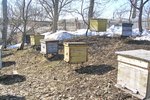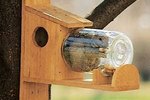
Squirrels don't really need humans to build homes for them, but they do need suitable mature trees in which to build their own homes. Unfortunately, large, older trees are just what many squirrels don't have in some places, so making nest boxes you can mount to younger trees or other structures helps increase habitat for these delightful little creatures and encourages them to re-evaluate the neighborhood. You can build a fancy nest box, but squirrels are happier in a plain wooden box built with their needs in mind.
Step 1
Measure from one end of the 1-by-10-inch-by-6-feet-long board and mark points along one edge at 16 inches, 30 inches, 44 inches, 60 inches and 68 inches. Starting from the same end, mark points along the opposite edge at 14 inches, 30 inches, 44 inches, 60 inches and 68 inches. The 4-inch remainder is scrap.
Step 2
Use a carpenter's square to draw lines connecting pairs of marks. The first two pieces have one 14-inch side and one 16-inch side -- the variance accommodates the roof slope.
Step 3
Mark the pieces in order as follows: side, side, front, back and floor, then cut them out with a saw.
Step 4
Cut the remaining scrap piece -- following the grain of the wood for the length -- into four 1-inch-wide strips that are 4 inches long. These aid young squirrels getting in and out of the box. Use 4-inch-long sections of 3/4-inch quarter-round trim instead if you prefer not to cut small pieces.
Step 5
Measure 1 inch down from the top of the front piece and cut a 3-inch-diameter entry hole using a jigsaw or a 3-inch hole saw bit on your drill.
Step 6
Measure 2.5 inches down from the bottom of the entry hole and glue one of the 4-inch strips across the front face at that spot. Measure 2.5 inches below the first strip and attach the second strip there. Repeat this step on the back side of the front piece for matching climbing rungs inside and out.
Step 7
Drill a 1/8-inch pilot hole on each end of both outside strips after the glue has set, and fasten the strips securely to the box with a 2-inch wood screw at each of those points. The screws penetrate to the inside strips to secure them, so you do not need additional screws on the inside.
Step 8
Drill two 1/8-inch pilot holes 2 inches apart vertically 1 inch from each end of the 1-by-3-inch-by-22-inch-long mounting board. Drill three additional holes, one in the center and one at 6 3/8 inches from each end. Drill three holes, centered, 2 inches from each edge, along a line 3/8 inch in from the back edge of the 1-by-12-inch-by-13-inch-long roof board. Set both pieces aside.
Step 9
Lay the side and floor pieces out on a flat work surface. Drill three 1/4-inch ventilation holes about 1 inch down from the top edge of each side piece, and one drain hole in the center of the floor piece.
Step 10
Assemble the box. Screw the front piece to both side pieces along the 14-inch edge using 1-1/2-inch wood screws, then screw the back onto the 16-inch edge of the sides – keeping everything square. Use pilot holes as needed to prevent splitting the wood.
Step 11
Place the floor section on a flat surface and fit the box over it to ensure it is square. Attach it to the bottom with 1-1/2-inch wood screws through all sides.
Step 12
Turn the box front-face down on the work surface, and center and attach the 22-inch-long mounting board to the back with wood screws through the three holes corresponding to the center and the top and bottom of the nest box -- the two holes predrilled at 6 3/8 inches from each end. Temporarily ignore the other holes drilled near the ends of this piece -- those are for mounting the nest box to a tree.
Step 13
Position the 1-by-12-inch-by-13-inch-long roof board at the top of the box -- centering it so it overhangs the sides equally and the back edge of the roof board is flush with the back of the box. Fasten it to the box top through the three previously drilled pilot holes.
Step 14
Add a scrap strip of aluminum flashing with roofing nails to the gap where the roof board meets the back. to keep rain out.
Step 15
Mount the box 20 to 30 feet high in a tree larger than 10 inches in diameter.
References
Resources
Photo Credits
-
Stockbyte/Stockbyte/Getty Images




